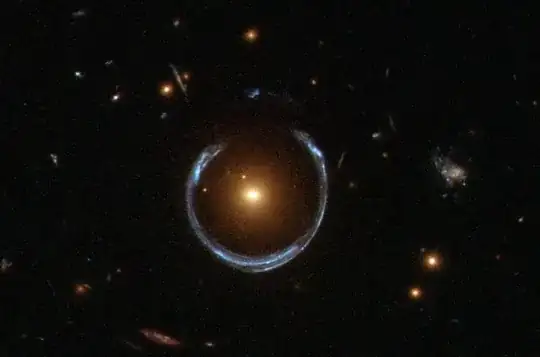Do gravitational lenses have a focus point? Could I burn space ants?
4 Answers
It's pretty easy to see that the gravitational lens doesn't have a focal point. Please excuse my very poor drawing:

Rays from the top are focused across a line. A black hole would have a "focus line" but not a focus point.
- 11,937
-
-
3As long as the black hole is spherical then there will be rotational symmetry about the drawn line and it will be a 1-dimensional line even in 3D. Of course, I drew this as a black hole but a spherically distributed mass galaxy would do just fine too except that the rays I drew stopping at the black hole would pass through a galaxy. – Brandon Enright Jan 02 '14 at 07:16
-
Why would a black hole, assuming it's spherical, have a focus "line?" Spheres don't seem to have a specific line of symmetry that's different from the others. – Jason Chen Sep 02 '14 at 03:33
-
1@JasonChen the symmetry is broken by incident collimated light — which is usual for analysis of lenses. – Ruslan Sep 15 '14 at 12:08
No.
Ordinary optical lenses deflect the light ray, at least in a linear polarization, by an angle that is linear as a function of the location $(x,y)$ on the lens: $$\theta \sim ax + by$$ Well, we should really talk about $\vec k$, the wave vector, a two-dimensional angle of a sort.
On the other hand, the deflection by the gravitational lens goes like an inverse power law $$ |\theta| \sim \frac{1}{r^n} $$ for some positive $n$, just like a gravitational force. The convergence requires the linear dependence from the first formula; the second formula doesn't imitate it in any approximation.
- 179,018
-
I take it that the images from a gravitational lense could not be seen as upside down / inverted either? – Jitter Jan 02 '14 at 07:13
-
Hi, they're not images at all according to a proper definition of an "image". Images only occur if the light rays from a source converge. ... In the approximation where the galaxies are moved just a little bit, the inversion isn't there. However, there's a point at which a galaxy may spread to a ring or multiple images etc. and inversions may occur beyond this singular point. – Luboš Motl Jan 02 '14 at 11:33
-
3What I got out of this answer is that we need to rethink our strategy for handling the clear and present "space ants" issue. – Vincent Vancalbergh Jan 02 '14 at 19:21
-
The gravitation lens generates smaller angular deflections at large impact factors. A converging lens generates larger angular deflections at larger impact parameters.
So, a first guess would be "no way".
Thinking simply about a point source such as a black hole, the equivalent optical lens created by such an object looks like the image below (taken from this article). That is to say it falls off as $\frac{1}{r}$ as pointed out by Lubos Motl in his answer.

This object has some interesting optical properties. The $\frac{1}{r}$ potential will act as a diverging optical lens for objects far from the axis. This is why gravitational lenses can be used to magnify distant objects. I.E. you wouldn't be able to burn the space ants, but you could use it to see them more clearly.
The discontinuity at the center of the lens will make it act like an optical object known as an axicon which, as is pointed out both in the linked wikipedia article and by Brandon in his answer, will image a point source to a line along the optical axis.

(source: edmundoptics.com)
There is a good paper on the properties of axicon's here at Optics InfoBase. One of the most interesting properties is that it can turn an image inside out; imaging points near the optical axis further from the axis than those that started further away. This property is what allows gravitational lenses to form multiple images of the same object in a ring-like pattern such as in the below image.

- 1,424
- 7,033
-
Thanks for the pics and links. I seem to have got a tumbleweed on one of my followup questions. If anyone wants to have a look you can find it here. http://physics.stackexchange.com/questions/92224/gravitational-lensing-image-from-merging-black-holes – Jitter Jan 17 '14 at 18:59
http://cdn.physorg.com/newman/gfx/video/2014/nasasfermima.mp4 from this article
http://phys.org/news/2014-01-fermi-observatory-gamma-ray-gravitational-lens.html
– Jitter Jan 08 '14 at 09:32